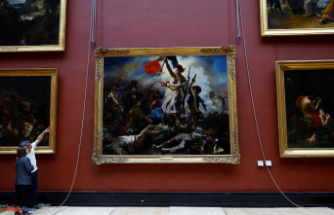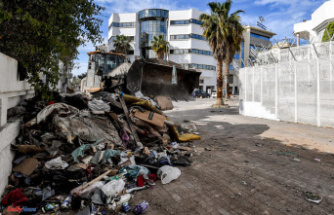“Morose delectation” is the title chosen by Gopal Dagnogo for his new exhibition at 110 Honoré, a Parisian gallery directed by Véronique Rieffel. “It’s a religious concept of taking pleasure in sadness, complaining in melancholy. I find that this oxymoron fairly aptly sums up the dissonances that govern our societies, the contradictions that govern the schizophrenic world in which we live,” underlines the Franco-Ivorian artist.
And to add: “A world that is both more civilized and more violent, more respectful and less tolerant, sickly hygienic and cruelly toxic, fiercely libertarian and slyly liberticidal. A declining civilizational model, incapable of introspection. »
“Rose Symphony”
The pictures are not as gloomy as this pessimistic observation. The dark side of humanity hardly emerges on the surface of the canvases, even if the construction of the works can confuse those who look at them by showing a real freedom in the composition ignoring the perspective dear to the Renaissance (from the 14th to Seventeenth century). Véronique Rieffel “loved this symphony of roses, this spring side, and I share with Gopal the taste for wordplay, beyond the cultural and religious allusions of the exhibition title”.
The gallery owner discovered the work of the visual artist at the 1-54 contemporary African art fair which was held in Marrakech, on February 24 and 25, 2018 at La Mamounia. Thanks to a mutual friend, the Ivorian sculptor Jems Koko Bi, she met him and was seduced by his unique universe and his humor. In November 2019, encouraged by the artistic director of the AKAA fair, Armelle Dakouo, Véronique Rieffel presented it in a solo show at the Carreau du Temple, in Paris: “A hit! “, she remembers.
Born in 1973 in Abidjan to an Ivorian father and a French mother, professor of fine arts and graduate of the National School of Decorative Arts in Paris, Gopal Dagnogo was introduced to aesthetics very early on, in a world where the smells of gouache and turpentine mixed: “I knew I would become a painter. I dreamed of freedom, music and painting. » Thanks to two of his brothers who also graduated in fine arts, he learned technique, without forgetting his taste for reading art history books.
At the age of 17, he left the Ivory Coast and arrived in Bordeaux, studying at a high school in Philosophy and Visual Arts. One of his teachers is none other than Jacques Abeille, a writer known under the open pseudonym Léo Barthe, influenced by the surrealist movement in which he participated in the 1960s and 1970s.
“My head-on encounter with conceptual art”
“He taught me with patience to deconstruct presuppositions, broaden the field of possibilities and avoid falling into the trap of the facilities I had for drawing and color. It led me, for example, to consider the work of Basquiat in other ways than the scribbles of a badly drugged zigoto. But the real shock was my head-on encounter with conceptual art at the CAPC [Museum of Contemporary Art in Bordeaux], in the fall of 1991. I was brutally confronted with walls covered in 8.7 cm scratches [of wide], like awning covers. It was Daniel Buren. It took me a while to get over it,” the painter recalls.
In 1997, to train in other artistic techniques, he left for Burkina Faso, the land of bronze casters, to learn the lost wax technique (precision casting to obtain a metal sculpture from a wax model). ). A stay which was to last one month, which will turn into a three-year residency. “To be honest, I’ve done very little bronze, but I don’t rule out returning to it one day,” he admits.
Influenced by the great masters of the Renaissance, Gopal Dagnogo is also influenced by more eccentric personalities who stand out for their audacity, the assurance of line, the power of chromatic balances: the post-impressionists Henri de Toulouse-Lautrec and Vincent Van Gogh, the Austrian expressionists Egon Schiele and Oskar Kokoschka.
In his still lifes – a classic and timeless theme of painting – presented at 110 Honoré, fish and chickens occupy pride of place. According to the visual artist, “Animal Farm, by George Orwell, wonderfully depicts this human animality. I sometimes have the feeling that we live in the heart of this dystopia. What if our world was just a giant chicken coop? Everyone is busy picking at their ration. And, for the most ambitious, the concern to covet the neighbor's portion of grain, with the ultimate objective of enslaving him.
“I relish the ‘pitiful-shabby’”
For him, it is a matter of paying homage to the banality of everyday life, of highlighting, of restoring an emotional value to objects that are at first glance uninteresting, but essential to our ordinary comfort. Its starting point is often one or more colors, without sketches or preparatory drawings.
When Gopal Dagnogo runs out of ideas, “there’s always a way to ‘force’ inspiration. Just get the canvas dirty. One task calls for another. Then another one. The picture builds itself. My role is then limited to placing in the middle of the joyful bric-a-brac a few recurring elements of our daily life: beers, sneakers, bottles, lemons, odd mathematical formulas…”
In art as in literature, his inclination shifts towards damaged works. He prefers Emile Ajar to Romain Gary, Ahmadou Kourouma to Gustave Flaubert. “I like it when it hits, when it’s dented, like Bukowski, Cioran or Adiaffi. I savor the “pitiful-shabby”, when we know how to laugh at misery and cry at human beauty,” he explains.
If the plastic works of contemporaries such as the South African William Kentridge, the Chinese Chen Zhen or the Japanese Yayoi Kusama struck him, he had just discovered those of the Senegalese Fally Sene Sow and “remains baba”.
Finally, upon entering 110 Honoré, visitors are struck by an armchair covered in its pink and orange poultry print. On the first floor, they will find, relates Véronique Rieffel, “a totally improbable installation, created in situ, and for which Gopal immersed himself day and night, a bit like in residence, which offers a whole gallery of extremely touching faces” .












